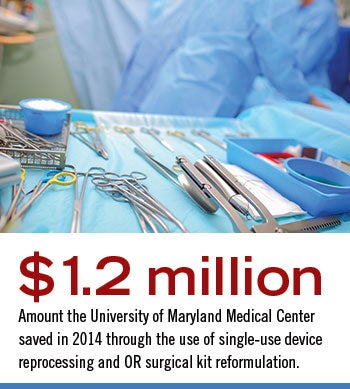Medical Center saves costs after 'Greening' its OR
 |
The University of Maryland Medical Center (UMMC), Baltimore, has achieved significant cost-cutting by implementing key data-driven sustainability measures in its operating rooms (ORs).
The medical center saved an estimated $1.2 million through single-use device reprocessing and OR surgical kit reformulation in 2014, says Justin Graves, R.N., the medical center’s sustainability manager. Additional savings were derived from more efficient energy usage, reduced medical waste and increased recycling.
The sustainability actions and related cost savings are the result of UMMC’s participation in the Greening the OR initiative of Practice Greenhealth, Reston, Va.
The association’s membership, which includes about 1,400 health care organizations that are committed to environmental stewardship at varying levels, provides technical resources, support and education to participating hospitals and health systems.
“UMMC got involved in this initiative because it’s the right thing to do for the environment and the health of the community, and it saves money,” Graves says. The medical center has participated in Practice Greenhealth sustainability initiatives since about 2007.
A key driver of cost savings is reprocessing medical equipment such as pulse oximeters and surgical instruments. “An organization can save from 40 to 60 percent of the original cost of medical devices by reprocessing them for future use,” he says.
Reducing the number of devices in operating room supply totes also has helped the medical center to save money. The totes are kits of medical supplies ranging up to hundreds of items requested by surgeons for procedures.
Unused, unopened items from the totes are usually returned to UMMC’s supplier at a cost to the medical center, and those that are opened and not used are disposed, used at the medical center for educational labs or donated to medical supply recovery organizations, Graves says.
Achieving a goal of reducing the number of items in the totes that are returned to the supplier unused to less than 2 percent of what was originally in the kits has helped to further cost-cutting, he adds.
“Every month, we review these surgical totes and what we’re not using and what we’re returning to the manufacturer,” says Jill Ciotta, R.N., UMMC’s operating room Green Team co-chair.




